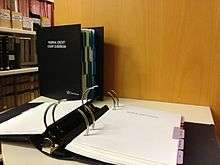Looseleaf service

A looseleaf service is a type of publication used in legal research which brings together both primary and secondary source materials on a specific field or topic in law. For this reason they are sometimes called "subject-matter services".
Looseleaf services are most commonly used for research in areas of law which change rapidly due to regulatory and administrative developments (such as tax law, environmental law, financial regulation, and labor law). Looseleaf services are typically contained in ring binders to keep them updated, because they are published fairly frequently (at minimum monthly, sometimes weekly or bi-weekly) in order to keep the information therein current. Most law libraries have a subscription to several of these services, and many of the more popular services are available electronically as well.
Types
Interfiled
In an interfiled looseleaf service, individual pages can be removed and replaced with more recent printings, eliminating the need for pocket parts or similar supplements. Most of the looseleaf services offered by Commerce Clearing House are of the interfiled type.
Newsletter-style
Newsletter-type looseleaf services are published as topical newsletters, which are then filed by law librarians under the appropriate topic headings for future reference.
One of the best-known looseleaf services, United States Law Week, is of this type. Most of the looseleaf services published by Bureau of National Affairs are newsletter-style.
History
Looseleaf service was invented by Richard Prentice Ettinger in 1914, founder of Prentice Hall. As a 19-year-old assistant to his Princeton University tax professor, he published the professor's book at his own risk. The first print run sold well and he ordered a second print run from an outside printing company. On the day that this second print run arrived, the United States Congress changed the tax law enough that the book was outdated. Faced with this challenge, Ettinger came up with the idea of cutting the pages (leaves) loose, replacing the few pages where changes in the tax code had occurred, drilling holes through the pages and putting them into a ring-binder. Even though it was more costly, it did have the benefit that future changes could easily be accommodated by simply exchanging a single leaf or group of pages.
See also
- Pocket part - another common method of updating hard copy legal reference works
External links
- Brief explanation of looseleaf services from Georgetown University Law Center
- More comprehensive explanation from Boston College Law School
